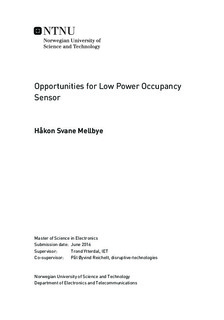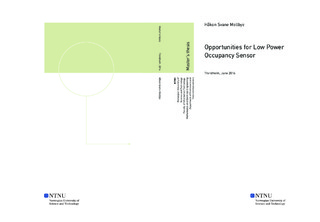| dc.description.abstract | Disruptive Technologies have developed a low power IoT chip. To further improve their chip, the task of developing a low power occupancy sensor was given. There are several commercially available motion detectors on the marked, but real occupancy sensors, with the possibility to detect presence and not only movement, is not in widespread use. To be able to detect presence two possible technologies are in focus in this thesis, ultrasound and radar. The main goal of the thesis, has been to show if it is possible to design a occupancy sensor, within the objectives given by Disruptive, the main objective is a average power consumption of 450nA. To be able to achieve this requirement it was chosen to focus on ultrasound technology and look closer at a possible COTS transducer.
There were made no test with the selected transducer, but calculations on the power consumption where made. These calculations showed, that it is not reasonable to assume that the selected transducer, could be made to comply with the stringent power requirements. To further make this case, test where performed with a secondary ultrasound transducer to demonstrate some of the issues with employing ultrasound, in a low power system. It was shown that ultrasound are prone to large propagation losses, giving it a range shorter than wanted. Based on the research done in this thesis it is not possible to make any final conclusion on the possibilities to use ultrasound in a low power occupancy system. It is however shown that ultrasound has some challenges not present with the use of radar. These challenges are connected to wave propagation, where ultrasound have a greater propagation loss compared to radio and to much time is spent listening and processing the echo signal with the use of ultrasound. For further research into the field of low power occupancy sensing, radar is therefore recommended, rather than ultrasound. | |

